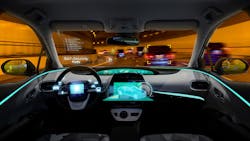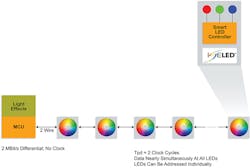Solving Automotive Interior Lighting Challenges with Integrated Smart Embedded LEDs
Automotive interiors have been undergoing a significant transformation over the past decade. Historically, many individual buttons in the cabin served a dedicated function. Interior switches in modern vehicles are more complex with shared functions, menu options, and interactive displays. Adding to complexity, human-machine-interface (HMI) interaction windows are used to control assisted driving and other content.
This transformation requires a move to sophisticated, controllable automotive interior solutions also enabling dynamic light effects. Practically nonexistent in the past other than for backlighting functions, these solutions are now becoming a de facto standard. For example, these solutions enable drivers to control the cockpit’s internal ambient light settings. Complex design, manufacturing, and implementation obstacles have made it challenging, though, to fully realize the benefits of these solutions.
The ISELED Alliance created a new type of calibrated, digitally addressable smart RGB LED module that’s integrated with a smart LED driver, otherwise referred to as an ISELED. Adding even the smallest, most simple 8-bit microcontroller (MCU) to this ISELED device enables it to be implemented exclusively in hardware without any software or CPU burden from the processor, while opening the door to new applications and innovation opportunities using a flexible, building-block design approach.
Ambient-Lighting System Challenges
Modern ambient-lighting system designs pose distinct manufacturing challenges. First, the light guide portion of the LED interior lamp can only be located with easy access to cabling. In the past, this was from left to right, in the foot section. The illumination in earlier cockpits could not be near the steering wheel, gear shift, or overhead console where it really made sense from a design perspective—it was simply where the light guide could be easily placed.
Also problematic was how to avoid the confusion of having buttons with multiple different shades of the same color located near each other. Eliminating this confusion has generally required using ambient-light LEDs of completely different colors, such as ambient-light blue on the light guide and orange on the steering wheel buttons.
Contributing factors for this challenge are that multiple sources of suppliers for the light guide, steering wheel, overhead console and door module are implementing ambient-light LED features. Further complicating this challenge, the LEDs are sourced from different suppliers across manufacturing batches, each with their own underlying aging and temperature drift curve.
In this fragmented supply chain, a variety of companies have a single core competency, with some focused on the steering wheel or capacitive-touch buttons while others specialize in cabling placement or LED manufacturing binning, compensation, and calibration. Until now, few companies could integrate everything that’s required for an ambient-lighting system. This stifles innovation and makes it difficult to implement safety-related functions on the steering wheel or the overhead console (Fig. 1).
The lack of synchronous communications between different light-enabled modules creates a fourth challenge: dynamic light effects are practically impossible to implement cost-effectively. For example, manufacturers of Level 3 autonomous vehicles want to use dynamic lighting effects in self-driving mode to alert drivers to hazards. Ambient green or blue lighting might be used in the cabin during autonomous mode.
To draw the driver’s attention back to traffic, the car would request that the driver take over steering-wheel functions. If there was no response after 10 seconds, the car would begin changing the illuminating color across the cabin from left to right through shades of yellow or red. Just before the driver must retake control of the steering wheel, the color would blink red. This functionality can only be enabled with a new generation of integrated, automotive interior-lighting technology. Combined with a microcontroller, this technology will be easy to implement and adaptable to innovative new use cases.
Enabling the Next Evolution of Automotive Interior Lighting
By integrating an intelligent device inside the LED module, ISELED modules are designed to take over all color temperature compensation, binning, and calibration. This will enable LEDs to behave identically from manufacturing batch to manufacturing batch and lot to lot, over both time and temperature. Each LED will display the exact same color temperature, and the calibration will be completed at the LED level. Major players like OSRAM and DOMINANT Opto already are producing these LEDs.
Another benefit is the daisy-chain capability of connecting more than 4,000 nodes with a very high data rate of 2 Mb/s (Fig. 2). This will enable dynamic light effects of various shading schemes and color mixes, among other new use cases. The ability to increase contrast and color quality through different LED backlight dynamic dimming stages will be useful in matrix rear-light applications, exterior lighting, and backlight display control.
Role of Microcontrollers
In practical applications, an MCU that combines a processor, memory, and peripherals will be needed to communicate to the ISELED LED string. It needs to have a special protocol with an ISELED-capable serial engine. A software and CPU burden will occur on the processor unless an MCU is designed to employ core independent peripherals (CIPs) with dedicated hardware peripherals like those in MCUs from Microchip Technology.
Such peripherals have been designed with additional capabilities to handle various tasks without relying on input from the CPU. These unique block sets can be interconnected with on-chip glue logic and other peripheral elements such as flip-flops, enabling an ISELED peripheral to be created exclusively in hardware. For example, Microchip’s MCU portfolio includes solutions that support ISELED from the smallest 8-bit MCU up to the 2-MB AUTOSAR 32-bit MCU.
The other benefit of this approach is that it allows developers to further advance innovation by mixing other major design block sets. An MCU can have a built-in ISELED module plus a local interconnect network (LIN) universal asynchronous receiver-transmitter (UART), and be equipped with LIN state-machine hardware as well as Sync Break and Autobaud UART features.
That same MCU can be manufactured with an integrated, hardware capacitive-touch module. Other options for inclusion are a bootloader, a capacitive-touch slider module, or a capacitive proximity sensor. With available bandwidth, these implementations can be completed using CIPs that minimize software and CPU cycle needs.
To create the smallest ISELED solution possible, a 32-bit MCU with CIPs can be used with an integrated load-dump-protected low-dropout regulator (LDO) and LIN transceiver in a 5- × 5-mm package, along with ISELED, LIN UART, and capacitive-touch peripheral touch controller (PTC) modules. The single-chip solution (ATSAMHA1 Family) includes everything from LIN communication to the ISELED, plus a proximity-sense Cap Touch module.
An ISELED module configuration is integrated in a separate downloadable file using a GUI-enabled tool that enables peripheral setup with a simple mouse click combined with other peripherals, such as touch and LIN modules. Development boards for MCUs provide simple click-on options for the ISELED plug in hardware, LIN transceiver and capacitive touch sensors. The ISELED strings are then clicked, the code configurator tool is launched, and the development process is quickly completed. The goal is to enable ISELED innovation quickly and easily as possible.
RGB interior lighting has posed complex system design and manufacturing challenges that have limited in-vehicle innovation. The ISELED Alliance and its members are working to solve these challenges by enabling ambient lighting to be combined with sensor, proximity, hands-on detection, and other functions. Today’s MCUs with CIPs accelerate ISELED development and LED innovation. From low-power, low-cost 8-bit MCUs to high-end 32-bit MCUs, today’s offerings combine everything from LIN communication to the ISELED as well as the power supply and capacitive-touch functionality.
Stefan Kouba is European Marketing Manager, Automotive Products Group, at Microchip Technology.


